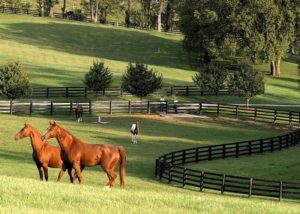Keeping the Pastures Alive
In the upcoming months, the grass will begin to grow at a slower pace. Being able to maintain healthy pastures is going to become more crucial. So to help, we have complied a few key points for your pasture maintenance.
Rotate your pastures! There are several benefits to rotating pastures. First, pasture rotation gives your pastures time to rest and grow. Grass should not get below 4 inches or else the roots risk becoming weak. The stronger the grass roots become, the less likely weeds will be able to invade.
Overgrazed pastures struggle to hold onto soil often allowing erosion. Overgrazed pastures also have higher parasite counts because horses spend too much time in the one confined space and therefore defecate multiple times in close proximity. If the pasture is not given time to rest and if the manure is not spread, you risk having high parasite counts.
When the grass starts to grow slower and winter begins rolling around, consider dedicating one pasture as the sacrifice area The sacrifice area will become overgrazed and the horses will need hay, but the other pastures can maintain their growth. Also, during poor, rainy weather, the sacrifice area will prevent the other pastures from being torn up.
Lastly, you can make sure your pastures have the proper nutrient levels by conducting a soil test. A soil test will determine the best fertilizer and lime requirements. The results of the test will improve your pasture growth and the carrying capacity of your soil.
By Anna Hellman
-
Articles
- April 2024
- March 2024
- February 2024
- January 2024
- December 2023
- November 2023
- October 2023
- September 2023
- August 2023
- July 2023
- June 2023
- May 2023
- April 2023
- March 2023
- February 2023
- December 2022
- November 2022
- October 2022
- September 2022
- August 2022
- July 2022
- June 2022
- May 2022
- April 2022
- March 2022
- February 2022
- January 2022
- December 2021
- November 2021
- October 2021
- September 2021
- August 2021
- July 2021
- May 2021
- April 2021
- March 2021
- February 2021
- January 2021
- December 2020
- November 2020
- October 2020
- September 2020
- August 2020
- July 2020
- June 2020
- May 2020
- April 2020
- March 2020
- February 2020
- January 2020
- December 2019
- November 2019
- October 2019
- September 2019
- August 2019
- July 2019
- June 2019
- May 2019
- April 2019
- March 2019
- February 2019
- January 2019
- December 2018
- November 2018
- October 2018
- September 2018
- August 2018
- July 2018
- June 2018
- May 2018
- April 2018
- March 2018
- February 2018
- January 2018
- November 2017
- October 2017
- September 2017
- August 2017
- July 2017
- June 2017
- May 2017
- April 2017
- March 2017
- February 2017
- January 2017
- December 2016
- October 2016
- September 2016
- August 2016
- July 2016
- June 2016
- May 2016
- April 2016
- March 2016
- February 2016
- January 2016
- December 2015
- November 2015
- October 2015
- August 2015
- June 2015
- May 2015
- March 2015
- November 2014
- March 2014
- October 2013
- September 2013
- August 2013
- January 2013
- December 2012
- November 2012
- October 2012
- September 2012
- January 2012
- October 2011
- September 2011
- August 2011
- July 2011
- June 2011
- February 2011
-
Meta






